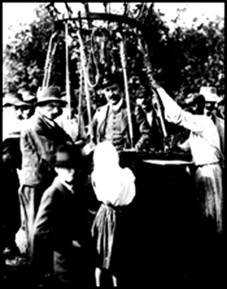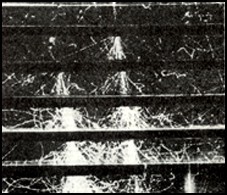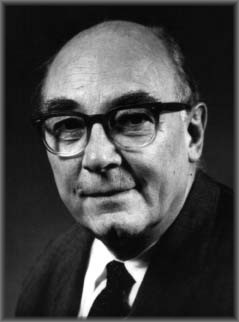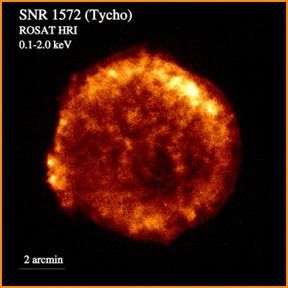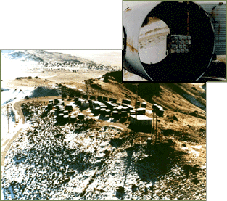|
|
||||||
| 1912 |
In the balloon at an altitude of 5,000 meters,Victor Hess,the father of cosmic ray research, discovered "penetrating radiation" coming from space. His was first of many adventurous journeys made by physisists to study cosmic rays |
|
Victor Hess, after his 1912 balloon flight. |
|||
| 1927 |
Using the cloud chamber, Dimitr Skobelzyn photographed the first ghostly tracks left by cosmic rays. |
|
Tracks of particles of cosmic ray particles in Wilson chamber. |
|||
| 1932 |
While watching the tracks of cosmic ray particles passing through his cloud chamber, Carl Anderson discovered antimatter in the form of the antielectron, later called the positron. A positron is a particle exactly like an electron, but with an opposite, positive charge. A debete raged over the nature of cosmic rays. According to a theory of Robert Millikan, they were gamma rays from space - hence the name "cosmic rays". But evidence was mounting that cosmic rays were, in fact, mostly energetic particles. |
|
||||
| 1937 |
Seth Neddermeyer and Carl Anderson discovered the elementary subatomic particle called the muon in cosmic rays. The positron and the muon were the first of a series of subatomic particles discovered using cosmic rays - discoveries that gave birth to the science of the elementary particle physics. Particle physicsts used cosmic rays for their research until the advent of particle accelerators in the 1950s. |
|
Carl Anderson, one of the discoverers of muon, the Nobel Prize winner for antimatter discovery. |
|||
| 1938 |
Pierre Auger, who had posisioned particle detectors located many meters apart both signaled the arrival of the particles at exactly the same time. Auger had discovered "extensive air showers", showers the secondary subatomic particles caused by the collision of the primary high-energy particles with air molecules. On the basis of his measurements, Auger concluded that he had observed showers with energies of 1015 eV - ten milion times higher than any known before. |
|
Pierre Auger (CERN photo).
|
|||
| 1946 |
Groups led by Bruno Rossi in USA and Georgi Zatsepin in Russia started experiments on the structure of Auger showers. These researchers constructed the first arrays of correlated detectors to detect air showers. |
|
Grigorij Zatsepin setting up air shower detectors in Russia. |
|||
| 1949 |
Enrico Fermi put forth an explanation for the acceleration of the cosmic rays. In Fermi's cosmic ray "shock" accelerator, protons speed up by bouncing off moving magnetic clouds in space. Exploding stars (supernovae) are believed to act as such cosmic acceleratos, but they alone cannot account for the highest-energy cosmic rays. |
|
The supernova remnant SNR 1572 (Tycho). The picture was obtained by the Rosat satellite. |
|||
| 1962 |
John Linsley and collaborators discovered the first cosmic ray with an energy of about 1020 eVin the Volcano Ranch array in New Mexico. |
|
John Linsley checking for rattlesnakes in the straw covering his detectors. |
|||
| 1966 |
In the early 1960s, Arno Penzias and Robert Wilson discovered that low-energy microwaves permeate the universe. Kenneth Greisen, Vadem Kuzmin and Georgi Zatsepin pointed out that high-energy cosmic rays would interact with the micriwave background. The interaction would reduce their energy, so that particles traveling long intergalactic distances could not have energies greater than 5*1019 eV . |
|
Map of the microwave background of the Universe recorded by the COBE satellite |
|||
| 1991 |
The Fly's Eye cosmic ray research group in U.S. observed a cosmic ray event with an energy of 3*1020 eV. Events with energies of 1020 eV had been reported in the previous 30 years, but this was clearly the most energetic. |
|
Fly's Eye Experiment, Utah, with original Fly's Eye detector (inset).(US Army photo). |
|||
| 1994 |
The AGASA Group in Japan and Yakutsk grouo in Russia each reported an event with an energy of 2*1020 eV.The Fly's Eye event and these events are higher in energy than any seen before. Where did these three high-energy cosmic rays come from? None seem to point back to an astrophysical object that could impart such enormous energies. |
|
Akeno, Japan - view of Akeno Giant Air Shower Array (AGASA).
|
|||
| 1995 |
An international group of researchers began design studie for a new cosmic ray observatory, the Pierre Auger Project, named in honor of the discovere of air showers. The new observatory will use a giant array of detectors to detect and measure large numbers from the very highest-energy cosmic rays. Tracing high-energy cosmic rays to their unknown souce will advance the understanding of the origin and evolution of the univerce. |
|
1600 detector stations will be spaced 1.5 km apart in 3000 square kilometer hexagonal grid. |
|||
|
|
|
|||||

